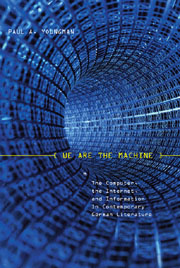Book contents
- Frontmatter
- Contents
- Preface
- Acknowledgments
- Introduction: Machines, Computers, and the Liberal Humanist Subject
- 1 Losing Ground to the Machine: Electronic Brains in the Works of Heinrich Hauser and Friedrich Dürrenmatt
- 2 Fearing the Machine — Two Nightmares in the 1990s: Gerd Heidenreich's New Riddle of the Sphinx and Barbara Frischmuth's Hidden Meaning
- 3 Becoming the Machine: Günter Grass's and Erich Loest's Virtual History, René Pollesch's Postdramatic Imaginings, and “Real” Cyber-Relationships according to Christine Eichel and Daniel Glattauer
- Conclusion: Questions to Ponder
- Bibliography
- Index
2 - Fearing the Machine — Two Nightmares in the 1990s: Gerd Heidenreich's New Riddle of the Sphinx and Barbara Frischmuth's Hidden Meaning
Published online by Cambridge University Press: 05 February 2013
- Frontmatter
- Contents
- Preface
- Acknowledgments
- Introduction: Machines, Computers, and the Liberal Humanist Subject
- 1 Losing Ground to the Machine: Electronic Brains in the Works of Heinrich Hauser and Friedrich Dürrenmatt
- 2 Fearing the Machine — Two Nightmares in the 1990s: Gerd Heidenreich's New Riddle of the Sphinx and Barbara Frischmuth's Hidden Meaning
- 3 Becoming the Machine: Günter Grass's and Erich Loest's Virtual History, René Pollesch's Postdramatic Imaginings, and “Real” Cyber-Relationships according to Christine Eichel and Daniel Glattauer
- Conclusion: Questions to Ponder
- Bibliography
- Index
Summary
In the network society, experience will be digital or not at all.
— Steven Shaviro, Connected: Or What It Means to Live in a Network Society (2003)The Virtual Reality Decade
ESCH ERA OF THE INFORMATION AGE fosters concerns that are specific to the developments that define the era, but none of those worries ever entirely disappear. In the beginning, for example, humans were concerned about the idea that a machine could calculate and process information. Humans, without necessarily knowing the name of the concept, were also worried about the Singularity, and given von Neumann's hypothesis, awed by the prospect of machine consciousness. Inasmuch as these concerns are about the boundaries humans use to define themselves, they remained firmly in place in the 1990s. In this decade, however, one begins to see new concerns crop up thanks to the many changes in IT.
Throughout the 1960s and 1970s, the speed of processing increased while computer component size decreased. There was also a massive increase in the pervasiveness of IT. But perhaps the most significant change occurred in the late 1960s. In 1968, Doug Engelbart, inventor of the computer mouse, developed the first word processor with a hypertext function. These two capabilities pulled IT out of the realm of calculating machines, already human terrain, and into the world of words (processing) and multi-level connections mimicking neural nets (hypertext). Thanks to Engelbart and the work of ARPA, the Internet became a reality one year later.
- Type
- Chapter
- Information
- We Are the MachineThe Computer, the Internet, and Information in Contemporary German Literature, pp. 62 - 93Publisher: Boydell & BrewerPrint publication year: 2009



